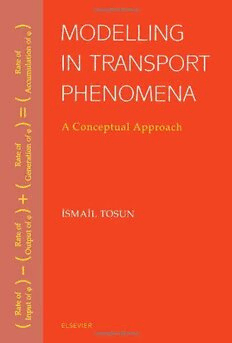
Modelling in Transport Phenomena: A Conceptual Approach PDF
Preview Modelling in Transport Phenomena: A Conceptual Approach
MODELLING IN TRANSPORT PHENOMENA A Conceptual Approach MODELLING IN TRANSPORT PHENOMENA A Conceptual Approach ISMAIL TOSUN Professor of Chemical Engineering Middle East Technical University Ankara, Turkey 2002 Elsevier Amsterdam - Boston - London - New York - Oxford - Paris San Diego - San Francisco - Singapore - Sydney - Tokyo ELSEVIER SCIENCE B.V. Sara Burgerhartstraat 25 P.O. Box 211,1000 AE Amsterdam, The Netherlands Q 2002 Elsevier Science B.V. All rights reserved. This work is protected under copyright by Elsevier Science, and the following terms and conditions apply to its use: Photocopying Single photocopies of single chapters may be made for personal use as allowed by national copyright laws. Permission of the Publisher and payment of a fee is required for all other photocopying, including multiple or systematic copying, copying for advertising or promotional purposes, resale, and all forms of document delivery. Special rates are available for educational institutions that wish to make phototopies for non-profit educational classroom use. Permissions may be sought directly from Elsevier Science via their homepage (http://www.elsevier.com) by selecting 'Customer support' and then 'Permissions'. Alternatively you can send an email to: [email protected], or fax to: (444)1 865 853333. In the USA, users may clear permissions and make payments through the Copyright Clearance Center, Inc., 222 Rosewood Drive, Danvers, MA 01923, USA; phone: (+1) (978) 750@400, fax: (+I) (978) 7504744, and in the UK through the Copyright Licensing Agency Rapid Clearance Service (CMCS),9 0 Tottenham Court Road, London WIP OW,U K; phone: (+44)2 W 631 5555; fax: (+44) 207 631 5500. Other countries may have a local reprographic rights agency for payments. Derivative Works Tables of contents may be reproduced for internal circulation, but permission of Elsevier Science is required for external resale or distribution of such material. Permission of the Publisher is required for all other derivative works, including compilations and translations. ElectronicS torage or Usage Permission of the Publisher is required to store or use electronically any material Contained in this work, including any chapter or part of a chapter Except as outlined above, no part of this work may be reproduced, stored in a retrieval system or transmitted in any form or by any means, electronic, mechanical, photocopying, recording or otherwise, without prior written permission of the Publisher. Address permissions requests to: Elsevier Science Global Rights Department, at the mail, fax and e-mail addresses noted above. Notice No responsibility is assumed by the Publisher for any injury and/or damage to persons or property as a matter of products liability, negligence or otherwise, or from any use or operation of any methods, products, instructions or ideas contained in the material herein. Because of rapid advances in the medical sciences, in particular, independent verification of diagnoses and drug dosages should be made. First edition 2002 British Library Cataloguing in Publication Data Tosun, Ismail Modelling in transport phenomena : a conceptual approach 1.Transport theory - Mathematical models 1.Title 530.1'38 ISBN 0444510524 Library of Congress Cataloging-in-PublicationD ata Tosun, Ismail. Modelling in transport phenomena : a concephlal approach I Ismail Tosm. p. cm. Includes bibliographical references and index. ISBN 0-444-51052-4 (alk. paper) I. TranspoR theory 2. Chemical engineering. I. Title. TP156.T7 T67 2002 66lY.28424~2I 2002072188 ISBN: 0-444-51052-4 8 The paper used in this publication meets the requirements of ANSI/NISO 239.48-1992 (Permanence of Paper). Printed in The Netherlands. TO Ayse Preface During their undergraduate education, students take various courses on fluid flow, heat transfer, mass transfer, chemical reaction engineering and thermodynamics. Most of the students, however, are unable to understand the links between the concepts covered in these courses and have difficulty in formulating equations, even of the simplest nature. This is a typical example of not seeing the forest for the trees. The pathway from the real problem to the mathematical problem has two stages: perception and formulation. The difliculties encountered in both of these stages can be easily resolved if students recognize the forest first. Examination of trees one by one comes at a later stage. In science and engineering, the forest is represented by the basic concepts, i.e., conservation of chemical species, conservation of mass, conservation of momen- tum, and conservation of energy. For each one of these conserved quantities, the following inventory rate equation can be written to describe the transformation of the particular conserved quantity cp : ( Rate of ) ( Rate of ) ( Rate of cp ) ( Rate of cp cp in - cp out generation = accumulation + in which the term cp may stand for chemical species, mass, momentum or energy. My main purpose in writing this textbook is to show students how to translate the inventory rate equation into mathematical terms at both the macroscopic and microscopic levels. It is not my intention to exploit various numerical techniques to solve the governing equations in momentum, energy and mass transport. The emphasis is on obtaining the equation representing a physical phenomenon and its interpretation. I have been using the draft chapters of this text in my third year Mathematical Modelling in Chemical Engineering course for the last two years. It is intended as an undergraduate textbook to be used in an (Introduction to) Transport Phenomena course in the junior year. This book can also be used in unit operations courses in conjunction with standard textbooks. Although it is written for students majoring in chemical engineering, it can also be used as a reference or supplementary text in environmental, mechanical, petroleum and civil engineering courses. The overview of the manuscript is shown schematically in the figure below. vii
